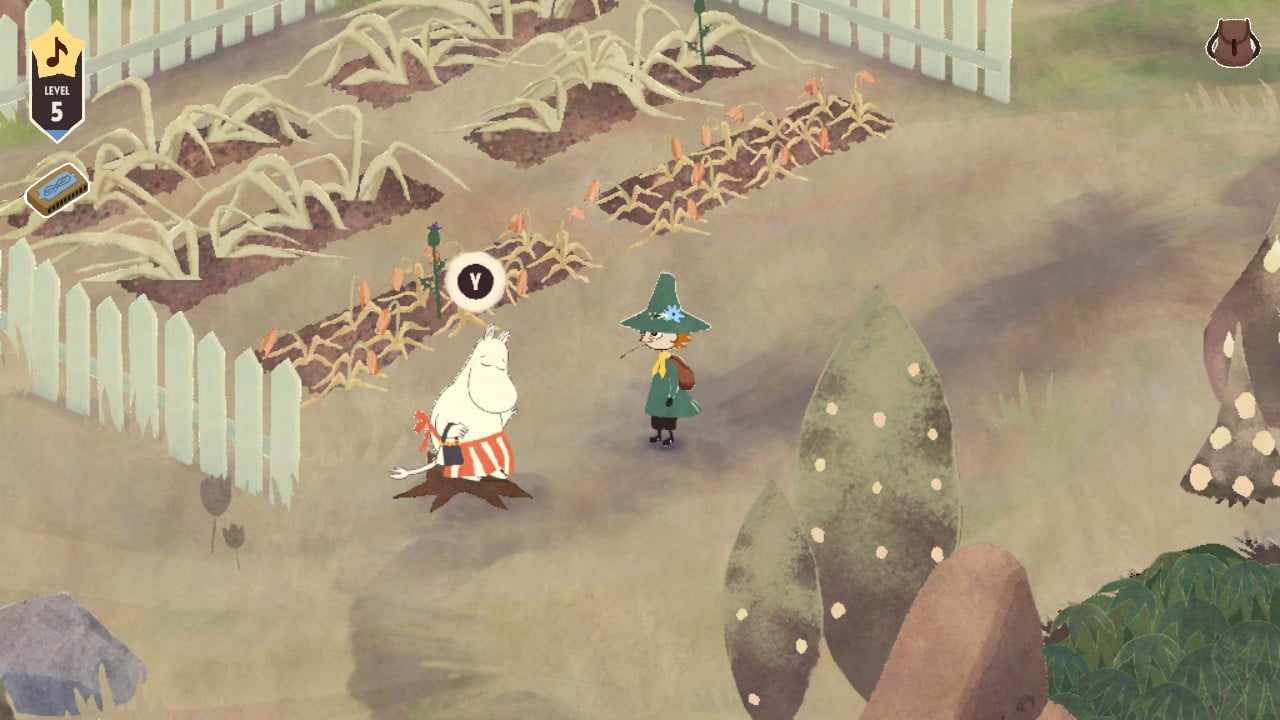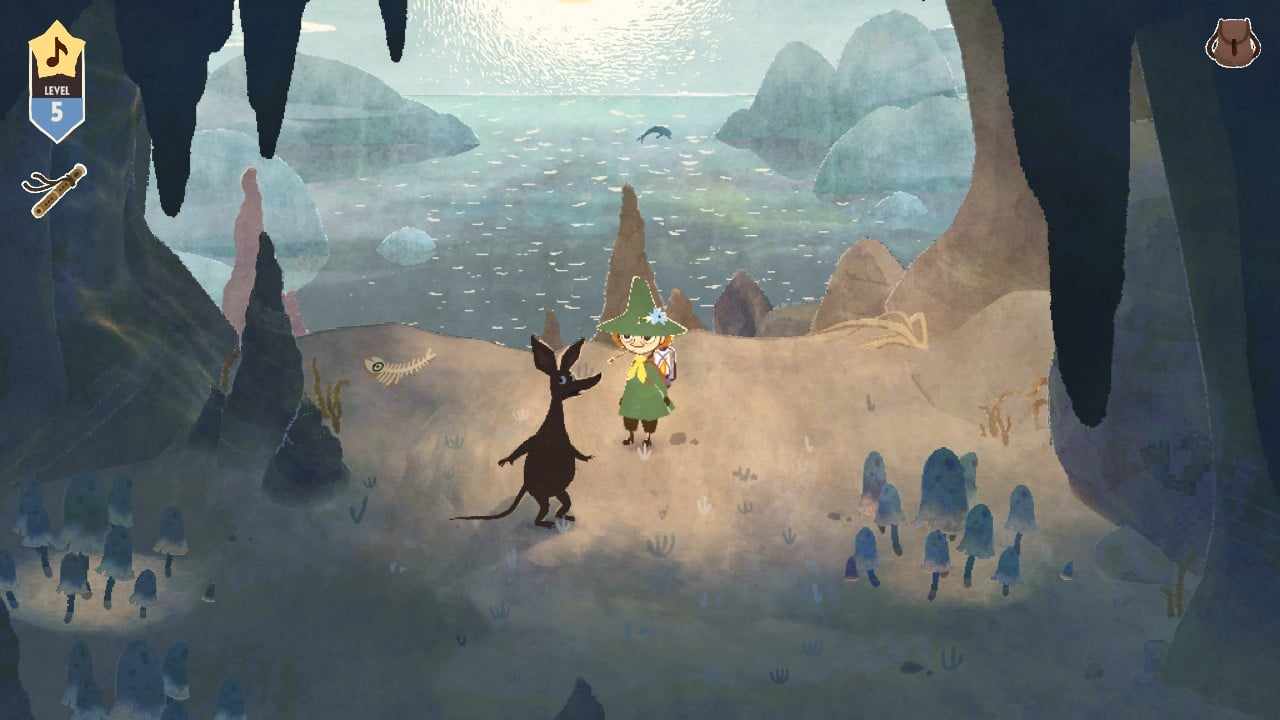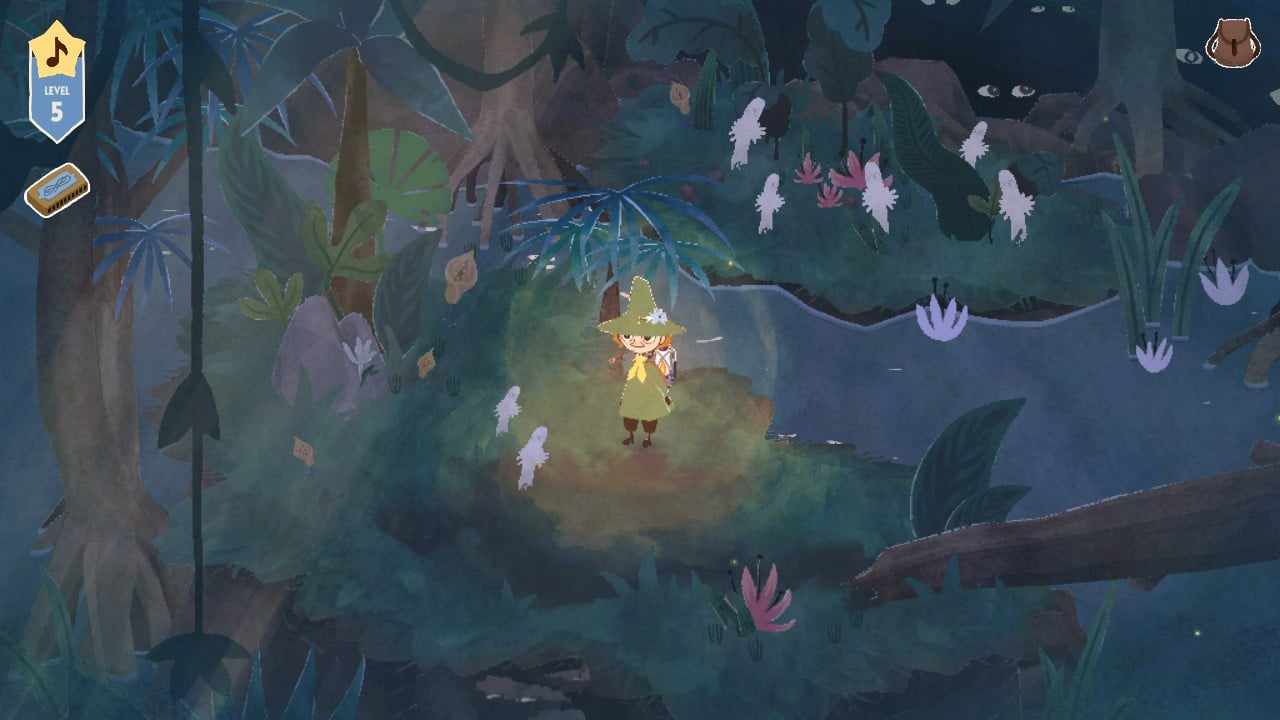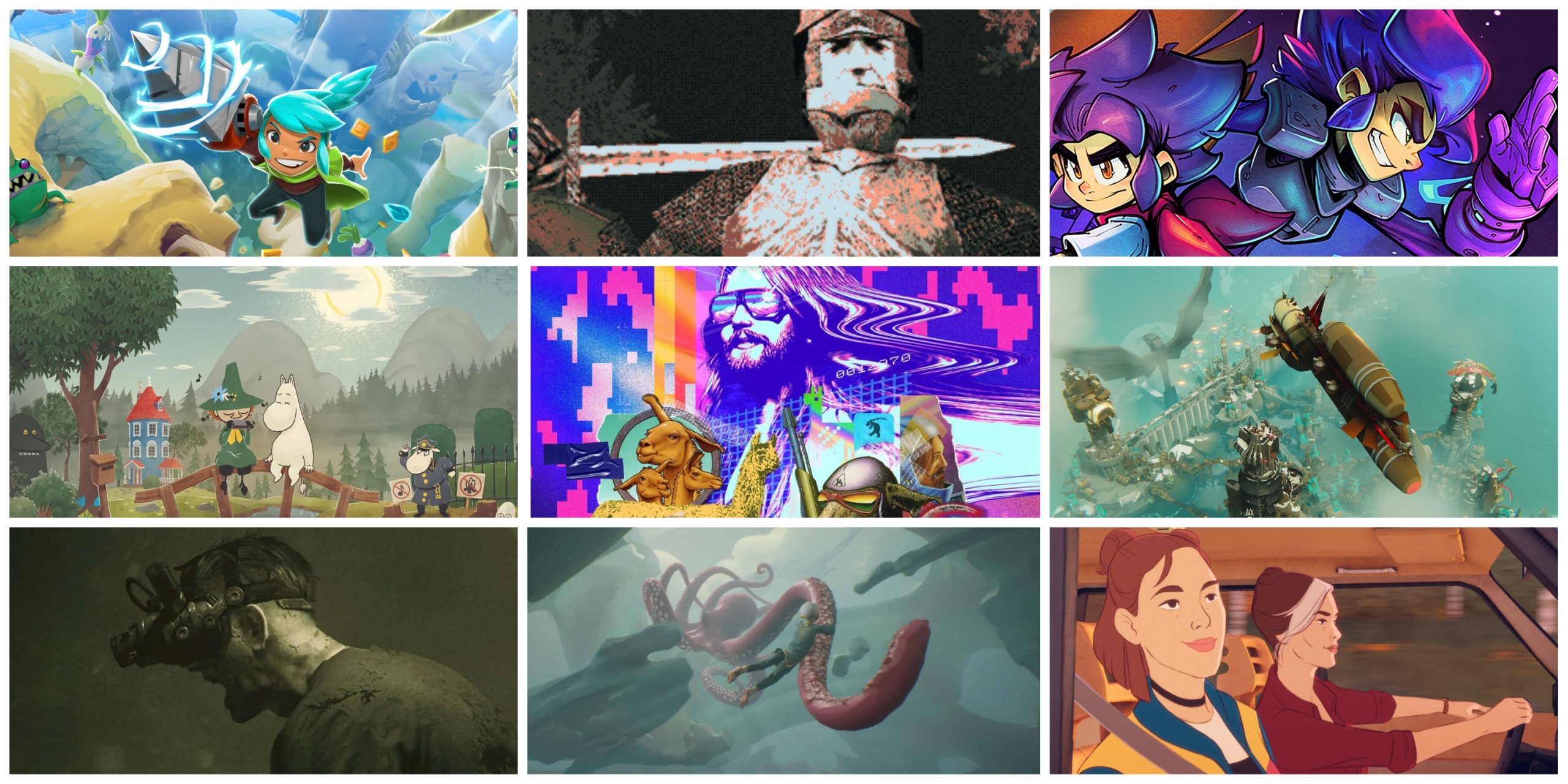Snufkin: Melody of Moominvalley Review (Switch) – MoominSpring Surprise
It’s not every day that an intellectual property from 1945 is turned into a videogame. But Moomin isn’t your everyday property. It’s not every day that it’s a faithful adaption of source material, or that it has the blessing of the author’s descendants and estate, or that it benefits from funding from the Norwegian Film Institute, or that it boasts music from Icelandic post-rock band Sigur Ros, or that…well the list goes on. Moomin is such a prevalent and worldwide brand that to get all this backing and support is both possible, and an impressive feat. Snufkin: Melody of Moominvalley is a little bit of an event.
If you’re of an age with me (late 30s) you probably grew up with the beloved early 90s anime series Moomin, one of the best and most faithful renditions of Moominvalley to date, but every generation has had new adaptations. In the 70s it was 2D almost felt-like animation, then later abortive attempts at an anime series, the 90s series that was so successful, and more recently a 3D computer-generated series airs for kids around the world. The Moomin brand has managed to stay relevant and heartwarming for kids of multiple generations.
So it was as a fan of the translated books, and the 90s anime as a child myself, that I booted up my Switch, sat down with my two-and-a-half-year-old son and started our journey into Moominvalley. The next generation to experience Moomins was sitting on my lap, and I almost blubbed thinking how wonderful it was to be able to share it with him in the form of a videogame.

Tales From Moominvalley
As he is wont to do every year, and this year being no exception, migratory adventurer Snufkin leaves Moominvalley just as Autumn ends, and whiles away his Winter fishing and snoozing. On his return come the first day of Spring he finds disastrous change has befallen Moominvalley in his absence. The Park Keeper has decided to cut down trees and put up signs to turn Moominvalley into a cultivated park, the Groke has kidnapped poor Moomin, rivers have been dammed, and plants and nature have shrivelled on the vine.
It is up to Snufkin, nature lover and all-round peaceful freedom-loving good egg that he is, to put it all to rights. He’s angry, but in that peaceful protest, non-confrontational, damage-to-signage kinda way. His plan is to upend the signs, take down the railings, and restore chaos to nature. It seems Moomin was one step ahead of him, trying to restore the valley when he was taken by the Groke.
And it’s within this framing that Snufkin will meet and interact with dozens of the characters and creatures of Moominvalley, be led on side quests by Little My, or collect flowers with the Hemulen, or even take a trip to the Hattifatteners’ island.

What makes Snufkin: Melody of Moominvalley’s story so successful is it does what we often wish games based on IPs would do, which is to just represent the source material to us in a world we can explore. Too often games try to reinvent or write a new story to such a degree that they forget the existing material. Snufkin: Melody of Moominvalley wallows in Tove Jansson’s material and sets its scenes as new uses of famous characters and stories. The first major mission is following the Groke, a fearsome childhood nightmare-maker that I remember from my own exposure to the Moomins as a child. The creature is part of the founding books and stories that Tove Janson wrote.
Then you make your way to the Hattifattener’s Island, again another setting full of creepy little creatures from the source material that gave the Moomins a hard time. Here it’s framed as a separate trip to an island you know about, and Snufkin deals with things as if the well-known stories had happened just last season. It’s respectful of its source material, while still framing the whole game around their original story of the park keeper’s destruction of Moominvalley. And while it may sound story-heavy, these aspects are often quite light-touch and kept to a small exchange of dialogue, and then the adventure and the exploration given over to the player.

The Adventures of Snufkin
Gameplay elements in Snufkin: Melody of Moominvalley are kept relatively minimal and to a small manageable number. It is primarily a walking sim with a couple of tasks and mechanics built around it. First is the melody of the title – Snufkin has three instruments by the end; a harmonica, flute and drum, that can charm, lead and surprise potential helpers or risks. For instance, if a snake blocks your path, you might need to charm them to sleep, or if it’s a frog they might need a surprise to move off a rock. Sometimes you can gather Creeps to help you reach higher ledges and areas.
Snufkin can jump and move rocks to help him get around, and he collects a variety of key items in his pack for use in completing quests. You spend much of your adventure looking for Moomin, but many other characters will pop up asking for Snufkin to mend a sail, or help reach treasure or find them a present. And while the majority are indeed ‘fetch’ quests, they all just flow together so naturally I barely thought of them as residing under that structural banner.

The other gameplay element is based around a little stealth. It’s thankfully not been shoehorned into masses of parts of the game, just the few necessary park areas. Police Officers patrol the parks and have little Metal Gear-esque view cones to show where they can see you. Snufkin’s job in most cases is to navigate these little mazes of conformity, uproot the signs, and do so without getting seen by the patrols otherwise it’s back to the start. There really aren’t any other mechanics to it – it’s all kept remarkably simple, but very much prioritising the story and exploration and making what might be regarded as gamified sections into something natural to play.
There are no bosses, no fights, no enemies beyond the patrolling policemen or the Groke, and even then no combat of any kind. The game easily fits under the wholesome description and never puts a foot wrong in terms of tone, content or what might be appropriate for younger players. In Snufkin: Melody of Moominvalley, the scarier side of Tove’s stories (the Hattifatteners, the Groke and a few caves and such) are toned down from the iterations of the Moomins that some have found scary over the years. These aspects are dealt with as more short bursts of tension, or chases. Not really what I’d call scary.
The only aspect I lamented as I explored was not being able to venture inside any dwellings – the famous windmill-like Moominhouse is closed to you and your explorations, as are the Fillyjonk’s house, the Park Keeper’s mansion etc. I would have loved to get a bit nosey in Moominpappa’s room or get up in the attic where Moomin would (sometimes manage to) sleep through winter. A small oversight, and perhaps to do with the constraints of the overhead camera, or the tone the game is going for. Whatever the reason, I’ll try to respect it, but I wish I’d been able to go inside.

Moominland Midwinter
Snufkin: Melody of Moominvalley is simply beautiful from start to finish. Like a living breathing watercolour that Tove Jansson might have painted, it kind of pulses with changes of colour and texture as if made of brushstrokes, and evokes the most wonderful side of all the many interpretations of the Moomins over the years. The character designs are unlikely to annoy diehard fans of any version that’s come before, and they certainly fit with the 90s anime. The maps especially were beautiful little ink drawings of Moominvalley and the separate Island.
Similarly, music and sound effects are used sparingly, but are also beautifully evocative. The game generally lulls between a kind of outdoor ambience and the minimal keening vocals of Sigur Ros when approaching something of note. The background music in the caves or when in stealth sections also sounded very in keeping, like it was a few bars or beats away from Sigur Ros chiming in. The music lends a great coherence to the whole valley, making it feel linked and tonally matched all over. Strangely enough, Sigur Ros’ penchant for singing in a made-up language also felt incredibly in keeping with a world where English wouldn’t really exist, and where there were no voiceovers beyond Zelda-like noises anyway.

As a medium the Switch is the perfect system with which to experience Snufkin’s little adventure. While you can use the joycons, the touchscreen allows you to guide Snufkin through Moominvalley in possibly the most accessible method there is. It allowed my two-year-old to help me play, moving his teeny tiny finger over the screen (totally getting in the way of course) and getting Snufkin wherever he needed to go with a bit of instruction. Of course the puzzles required us to work together (and were certainly beyond a two-year-old), but with the inclusion of Switch touchscreen control he was suddenly involved, and had far more agency than he can typically handle on video games at his age.
Exploring Moominvalley and reaching the point of restoring everything probably comes in at sub-five hours, even if you do virtually every subquest before the final confrontation. But like a sweet snack prepared by Moominmama, that’s not necessarily a bad thing. Snufkin: Melody of Moominvalley manages to cram in what feels like a nice amount of content, a few substantial levels and quests, and comes to something of a natural narrative conclusion without overstaying its welcome. I worried I was going to be clearing dozens of parks like I might in an overstuffed bland open world title, but there were probably only five or so in total, and all tied to the areas you visited in the story. It is an open valley, but one with just the right amount of easter eggs to discover and tasks to take on.
Presented in timeless watercolour, Snufkin: Melody of Moominvalley is a beautiful and heartwarming recreation of Moominvalley in videogame form. Being true to its source material throughout while introducing new elements like Sigur Ros’s music, elevates the experience close to definitive. If you want to share Moominvalley with anyone, or simply bask in a world we’ve collectively know for generations, this is now the best way to do it.

Snufkin: Melody of Moominvalley is available now on Nintendo Switch (review platform) and PC via Steam.
Developer: Hyper Games
Publisher: Raw Fury
Disclaimer: In order to complete this review, we were provided with a promotional copy of the game. For our full review policy, please go here.
If you enjoyed this article or any more of our content, please consider our Patreon.
Make sure to follow Finger Guns on our social channels –Twitter, Facebook, Twitch, Spotify or Apple Podcasts – to keep up to date on our news, reviews and features.



